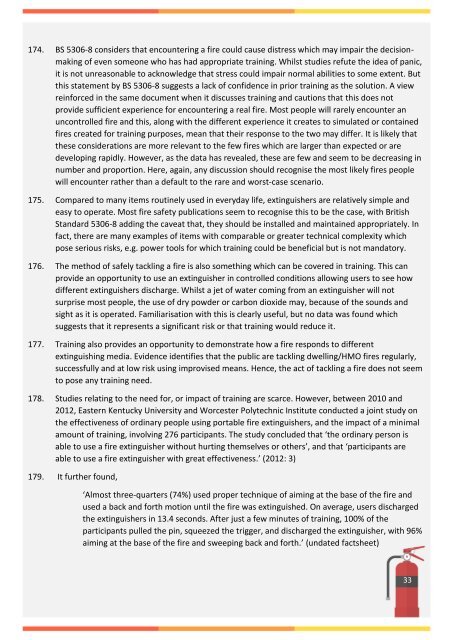An evaluation of the role of fire extinguishers
A report considering the role of a fire extinguisher in human terms identifying the gap between policy assumptions and the evidence from real fires. It considers the implications arising from this and makes a number of recommendations to create an evidence base and enhance current fire safety policies/advice.
A report considering the role of a fire extinguisher in human terms identifying the gap between policy assumptions and the evidence from real fires. It considers the implications arising from this and makes a number of recommendations to create an evidence base and enhance current fire safety policies/advice.
You also want an ePaper? Increase the reach of your titles
YUMPU automatically turns print PDFs into web optimized ePapers that Google loves.
174. BS 5306-8 considers that encountering a <strong>fire</strong> could cause distress which may impair <strong>the</strong> decisionmaking<br />
<strong>of</strong> even someone who has had appropriate training. Whilst studies refute <strong>the</strong> idea <strong>of</strong> panic,<br />
it is not unreasonable to acknowledge that stress could impair normal abilities to some extent. But<br />
this statement by BS 5306-8 suggests a lack <strong>of</strong> confidence in prior training as <strong>the</strong> solution. A view<br />
reinforced in <strong>the</strong> same document when it discusses training and cautions that this does not<br />
provide sufficient experience for encountering a real <strong>fire</strong>. Most people will rarely encounter an<br />
uncontrolled <strong>fire</strong> and this, along with <strong>the</strong> different experience it creates to simulated or contained<br />
<strong>fire</strong>s created for training purposes, mean that <strong>the</strong>ir response to <strong>the</strong> two may differ. It is likely that<br />
<strong>the</strong>se considerations are more relevant to <strong>the</strong> few <strong>fire</strong>s which are larger than expected or are<br />
developing rapidly. However, as <strong>the</strong> data has revealed, <strong>the</strong>se are few and seem to be decreasing in<br />
number and proportion. Here, again, any discussion should recognise <strong>the</strong> most likely <strong>fire</strong>s people<br />
will encounter ra<strong>the</strong>r than a default to <strong>the</strong> rare and worst-case scenario.<br />
175. Compared to many items routinely used in everyday life, <strong>extinguishers</strong> are relatively simple and<br />
easy to operate. Most <strong>fire</strong> safety publications seem to recognise this to be <strong>the</strong> case, with British<br />
Standard 5306-8 adding <strong>the</strong> caveat that, <strong>the</strong>y should be installed and maintained appropriately. In<br />
fact, <strong>the</strong>re are many examples <strong>of</strong> items with comparable or greater technical complexity which<br />
pose serious risks, e.g. power tools for which training could be beneficial but is not mandatory.<br />
176. The method <strong>of</strong> safely tackling a <strong>fire</strong> is also something which can be covered in training. This can<br />
provide an opportunity to use an extinguisher in controlled conditions allowing users to see how<br />
different <strong>extinguishers</strong> discharge. Whilst a jet <strong>of</strong> water coming from an extinguisher will not<br />
surprise most people, <strong>the</strong> use <strong>of</strong> dry powder or carbon dioxide may, because <strong>of</strong> <strong>the</strong> sounds and<br />
sight as it is operated. Familiarisation with this is clearly useful, but no data was found which<br />
suggests that it represents a significant risk or that training would reduce it.<br />
177. Training also provides an opportunity to demonstrate how a <strong>fire</strong> responds to different<br />
extinguishing media. Evidence identifies that <strong>the</strong> public are tackling dwelling/HMO <strong>fire</strong>s regularly,<br />
successfully and at low risk using improvised means. Hence, <strong>the</strong> act <strong>of</strong> tackling a <strong>fire</strong> does not seem<br />
to pose any training need.<br />
178. Studies relating to <strong>the</strong> need for, or impact <strong>of</strong> training are scarce. However, between 2010 and<br />
2012, Eastern Kentucky University and Worcester Polytechnic Institute conducted a joint study on<br />
<strong>the</strong> effectiveness <strong>of</strong> ordinary people using portable <strong>fire</strong> <strong>extinguishers</strong>, and <strong>the</strong> impact <strong>of</strong> a minimal<br />
amount <strong>of</strong> training, involving 276 participants. The study concluded that ‘<strong>the</strong> ordinary person is<br />
able to use a <strong>fire</strong> extinguisher without hurting <strong>the</strong>mselves or o<strong>the</strong>rs’, and that ‘participants are<br />
able to use a <strong>fire</strong> extinguisher with great effectiveness.’ (2012: 3)<br />
179. It fur<strong>the</strong>r found,<br />
‘Almost three-quarters (74%) used proper technique <strong>of</strong> aiming at <strong>the</strong> base <strong>of</strong> <strong>the</strong> <strong>fire</strong> and<br />
used a back and forth motion until <strong>the</strong> <strong>fire</strong> was extinguished. On average, users discharged<br />
<strong>the</strong> <strong>extinguishers</strong> in 13.4 seconds. After just a few minutes <strong>of</strong> training, 100% <strong>of</strong> <strong>the</strong><br />
participants pulled <strong>the</strong> pin, squeezed <strong>the</strong> trigger, and discharged <strong>the</strong> extinguisher, with 96%<br />
aiming at <strong>the</strong> base <strong>of</strong> <strong>the</strong> <strong>fire</strong> and sweeping back and forth.’ (undated factsheet)<br />
33<br />
1




